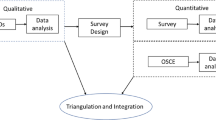Abstract
Purpose
The relationship between the pedagogical method and technology warrants further research to determine the benefits to students, instructors, and administrations. Technology-assisted learning has become an imperative part of higher education following the COVID-19 pandemic. Instructors now must evaluate their use of technology and its interaction with their course content. This article examines the impact of technology use in the Wayne State Univerisity Clinical Lab Science program, specifically within the discipline of Hematology.
Methods
The three technologies incorporated in the study were Kahoot, Red Blood Cell Simulator, and Digital Differentials. Kahoot is a student response quiz system, RBC Simulator and Digital Differentials are different types of simulated microscope practice tools. Surveys collected open-ended qualitative and quantitative Likert-scale data from 42 students from the 2019 and 2022 cohorts.
Results
Data revealed that students were comfortable using the technologies and that each had unique benefits to the learning process. Kahoot encouraged participation in the classroom, Red Blood Cell Simulator offered flexibility of laboratory practice at home, and Digital Differentials provided a simulated lab experience which enhanced information retention.
Conclusion
Data from the surveys communicated in what context the use of tools is most optimal, and reaffirmed that their presence in the course is valuable to student learning.



Similar content being viewed by others
Data availability
Not applicable
Code availability
Not applicable
References
Ng K-H, Stoeva M. Medical physics during the COVID-19 pandemic: global perspectives in clinical practice, Education and Research. CRC Press, Boca Raton, FL. Doi:https://doi.org/10.1201/9781003144380.
Tabakov S. History of Medical Physics e-Learning Introduction and First Activities – Iomp History of Medical Physics. https://www.mpijournal.org/pdf/2018-SI-01/MPI-2018-SI-01-p82.pdf.
Davis GA, Kohun FG. Information and Communication Technology in the Classroom: BYOD and the University’s role. Inform Syst Educ J. 2018;16(5):4.
Pinto M, Leite C. Digital technologies in support of students learning in Higher Education: literature review. Digit Educ Rev. 2020;37343–60. https://doi.org/10.1344/der.2020.37.343-360.
Sutton KK, DeSantis J. Beyond change blindness: embracing the technology revolution in higher education. Innov Educ Teach Int. 2017;54(3):223–8. https://doi.org/10.1080/14703297.2016.1174592.
Murray J, Wolf P. Faculty experience teaching in an interdisciplinary first-year seminar program: the case of the University of Guelph. Can J Scholarsh Teach Learn. 2016;7(1):1–21. https://doi.org/10.5206/cjsotl-rcacea.2016.1.4.
Saleh AM, Shabila NP, Dabbagh AA, Al-Tawil NG, Al-Hadithi TS. A qualitative assessment of faculty perspectives of small group teaching experience in Iraq. BMC Med Educ. 2015;1519. https://doi.org/10.1186/s12909-015-0304-7.
Wang XC, Kong SC, Huang RH. Influence of digital equipment on interaction quality in technology-rich classroom. In: 2016 IEEE 16th International Conference on Advanced Learning Technologies (ICALT). IEEE; 2016.
Ferster J. Teaching machines: learning from the intersection of Education and Technology. Johns Hopkins University Press; 2014.
Zhang A, Zhou T. Future classroom design of teaching from the perspective of educational technology. In: 2017 International Conference of Educational Innovation through Technology (EITT). IEEE; 2017.
2016 IEEE 16th International Conference on Advanced Learning Technologies (ICALT).; 2016.https://doiorg.ezp.waldenulibrary.org/10.1109/ICALT.2016.82.
Downie S, University of Wollongong, Australia, Gao X et al. Technology enhanced learning environments in higher education: A cross-discipline study on teacher and student perceptions. J Univ Teach Learn Pract. 2021;18(4):147–168. doi:https://doi.org/10.53761/1.18.4.12.
Petto A. Research and teaching: Technology meets pedagogy: comparing classroom response systems. J Coll Sci Teach. 2019;048(04). https://doi.org/10.2505/4/jcst19_048_04_55.
Wali AZ, Popal AW. The emerging issues and impacts of technology in classroom learning. Int J Emerg Technol Learn. 2020;15(15):237. https://doi.org/10.3991/ijet.v15i15.14175.
Barry S, Murphy K, Drew S. From deconstructive misalignment to constructive alignment: exploring student uses of mobile technologies in university classrooms. Comput Educ. 2015;81:202–10. https://doi.org/10.1016/j.compedu.2014.10.014.
Funding
not applicable.
Author information
Authors and Affiliations
Corresponding author
Ethics declarations
Ethics approval
Study waiver by the IRB Board of Wayne State University, exempt: 044719B3X
Conflicts of interests
There are no conflicts of interests nor funding sources for this study
Additional information
Publisher’s Note
Springer Nature remains neutral with regard to jurisdictional claims in published maps and institutional affiliations.
Rights and permissions
Springer Nature or its licensor (e.g. a society or other partner) holds exclusive rights to this article under a publishing agreement with the author(s) or other rightsholder(s); author self-archiving of the accepted manuscript version of this article is solely governed by the terms of such publishing agreement and applicable law.
About this article
Cite this article
Stewart, M., Lund, M. & McQuillen, E.P. Technology as a lecture enhancement tool in the clinical laboratory science classroom. Health Technol. 13, 631–637 (2023). https://doi.org/10.1007/s12553-023-00768-w
Received:
Accepted:
Published:
Issue Date:
DOI: https://doi.org/10.1007/s12553-023-00768-w



